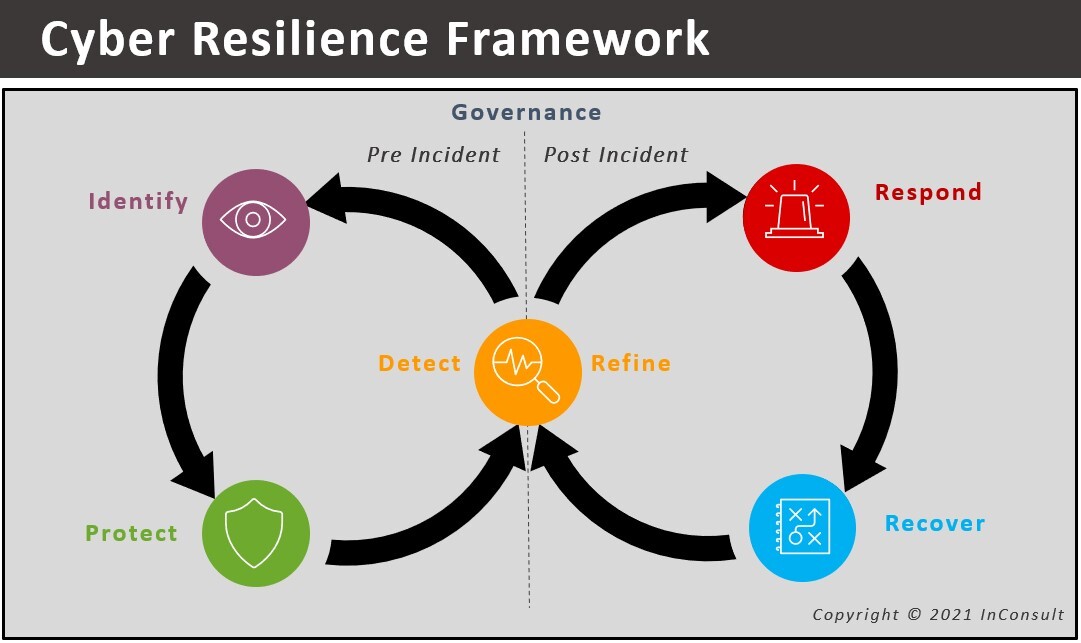The cybersecurity of medical devices is a critical aspect of ensuring patient safety, regulatory compliance, and operational efficiency in modern healthcare environments. With the increasing adoption of connected medical devices, these systems are now more vulnerable than ever to cyber threats. A robust cybersecurity posture is essential to mitigate risks, and focusing on four key areas - Resiliency, Availability, Hardening, and Recovery - can dramatically improve the security of medical devices.

The picture was borrowed from: inconsult.com.au
1. Resiliency: Building Systems That Endure
Resiliency refers to the ability of a medical device to withstand and recover from adverse events, such as cyberattacks or system failures, without compromising functionality. By incorporating resiliency into a device's design, manufacturers can ensure that critical operations, like data transmission or device functionality, continue uninterrupted during an attack.
Key strategies for achieving resiliency include:
- Load Balancing: Distributing workloads across multiple systems to avoid overloading a single point.
- Fault Tolerance: Designing redundant systems that continue to operate if one component fails.
- Regular Stress Testing: Simulating real-world attack scenarios to identify vulnerabilities and improve system endurance.
For example, a medical imaging device could use backup communication channels to ensure uninterrupted transmission of diagnostic data in case the primary network fails.
2. Availability: Ensuring Uninterrupted Access
Availability ensures that medical devices and their data are accessible when needed, particularly during critical procedures. Downtime or unavailability can lead to delays in patient care, eroding trust and potentially causing harm. Cyberattacks, such as Distributed Denial of Service (DDoS) attacks, specifically target availability to disrupt healthcare services.
To bolster availability:
- Redundant Systems: Implement backup systems that can take over seamlessly during failures.
- Monitoring and Alerts: Use continuous monitoring tools to detect unusual traffic or potential disruptions.
- Real-Time Failover Solutions: Enable instant switching to backup systems in case of primary system failure.
Ensuring availability is particularly important for devices used in life-saving scenarios, such as ventilators or infusion pumps, where downtime could directly impact patient outcomes.
3. Hardening: Fortifying the Device Against Attacks
System hardening involves strengthening the device’s defenses to minimize vulnerabilities. This is a proactive approach that significantly reduces the attack surface, making it more difficult for threat actors to exploit weaknesses.
Effective hardening strategies include:
- Removing Unnecessary Features: Disable unused ports, protocols, and services to limit entry points for attackers.
- Secure Configurations: Apply industry best practices for system settings, such as enabling encryption and enforcing strong authentication mechanisms.
- Regular Patch Management: Address known vulnerabilities through timely updates.
For example, a smart insulin pump can be hardened by implementing secure boot processes and disabling default administrative credentials, ensuring that only authenticated users have access.
4. Recovery: Planning for the Worst
Despite the best defenses, no system is completely immune to breaches or failures. Recovery ensures that, when an issue occurs, the system can be restored quickly and with minimal impact on patient care.
A comprehensive recovery plan includes:
- Data Backups: Regularly backing up device data to prevent loss in case of an attack or hardware failure.
- Incident Response Plans: Documented procedures for identifying, containing, and recovering from cybersecurity incidents.
- Testing and Drills: Periodically testing recovery plans to ensure they are effective and up-to-date.
For instance, an IoT-enabled cardiac monitoring device should include a recovery mechanism that allows clinicians to access patient data through a secure backup, even during an outage.
How These Practices Improve Cybersecurity Posture
By integrating resiliency, availability, hardening, and recovery into the design and operation of medical devices, manufacturers can achieve several key cybersecurity benefits:
- Minimized Downtime: Ensures continuous availability, even during attacks or failures.
- Improved Patient Trust: Demonstrates a commitment to safeguarding sensitive patient data and maintaining device reliability.
- Regulatory Compliance: Aligns with FDA and international cybersecurity guidelines, such as the IMDRF's principles for medical device cybersecurity.
- Reduced Attack Surface: Proactively prevents vulnerabilities from being exploited.
These measures not only protect against malicious actors but also ensure that devices meet the rigorous demands of healthcare environments, where every second can impact a patient's life.
Conclusion
In today’s connected healthcare landscape, cybersecurity is not optional—it is a necessity. Focusing on resiliency, availability, hardening, and recovery helps manufacturers and healthcare providers create robust, secure systems that can withstand evolving cyber threats. By adopting these best practices, the medical device industry can ensure safer, more reliable care for patients while maintaining compliance with regulatory standards.
Would you like to discuss how to implement these practices in your medical devices? Reach out to explore tailored solutions for your cybersecurity needs.
